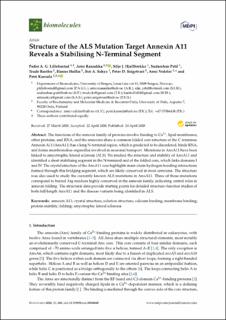| dc.contributor.author | Lillebostad, Peder August Gudmundsen | |
| dc.contributor.author | Raasakka, Arne | |
| dc.contributor.author | Hjellbrekke, Silje Johannessen | |
| dc.contributor.author | Patil, Sudarshan | |
| dc.contributor.author | Røstbø, Trude Kvalnes | |
| dc.contributor.author | Hollås, Hanne | |
| dc.contributor.author | Sakya, Siri | |
| dc.contributor.author | Szigetvari, Peter Daniel | |
| dc.contributor.author | Vedeler, Anni | |
| dc.contributor.author | Kursula, Petri | |
| dc.date.accessioned | 2021-06-14T07:38:19Z | |
| dc.date.available | 2021-06-14T07:38:19Z | |
| dc.date.created | 2021-01-06T14:09:11Z | |
| dc.date.issued | 2020 | |
| dc.identifier.issn | 2218-273X | |
| dc.identifier.uri | https://hdl.handle.net/11250/2759172 | |
| dc.description.abstract | The functions of the annexin family of proteins involve binding to Ca2+, lipid membranes, other proteins, and RNA, and the annexins share a common folded core structure at the C terminus. Annexin A11 (AnxA11) has a long N-terminal region, which is predicted to be disordered, binds RNA, and forms membraneless organelles involved in neuronal transport. Mutations in AnxA11 have been linked to amyotrophic lateral sclerosis (ALS). We studied the structure and stability of AnxA11 and identified a short stabilising segment in the N-terminal end of the folded core, which links domains I and IV. The crystal structure of the AnxA11 core highlights main-chain hydrogen bonding interactions formed through this bridging segment, which are likely conserved in most annexins. The structure was also used to study the currently known ALS mutations in AnxA11. Three of these mutations correspond to buried Arg residues highly conserved in the annexin family, indicating central roles in annexin folding. The structural data provide starting points for detailed structure–function studies of both full-length AnxA11 and the disease variants being identified in ALS. | en_US |
| dc.language.iso | eng | en_US |
| dc.publisher | MDPI | en_US |
| dc.rights | Navngivelse 4.0 Internasjonal | * |
| dc.rights.uri | http://creativecommons.org/licenses/by/4.0/deed.no | * |
| dc.title | Structure of the ALS Mutation Target Annexin A11 Reveals a Stabilising N-Terminal Segment | en_US |
| dc.type | Journal article | en_US |
| dc.type | Peer reviewed | en_US |
| dc.description.version | publishedVersion | en_US |
| dc.rights.holder | Copyright 2020 by the authors. | en_US |
| dc.source.articlenumber | 660 | en_US |
| cristin.ispublished | true | |
| cristin.fulltext | original | |
| cristin.qualitycode | 1 | |
| dc.identifier.doi | 10.3390/biom10040660 | |
| dc.identifier.cristin | 1866374 | |
| dc.source.journal | Biomolecules | en_US |
| dc.identifier.citation | Biomolecules. 2020, 10 (4), 660. | en_US |
| dc.source.volume | 10 | en_US |
| dc.source.issue | 4 | en_US |

